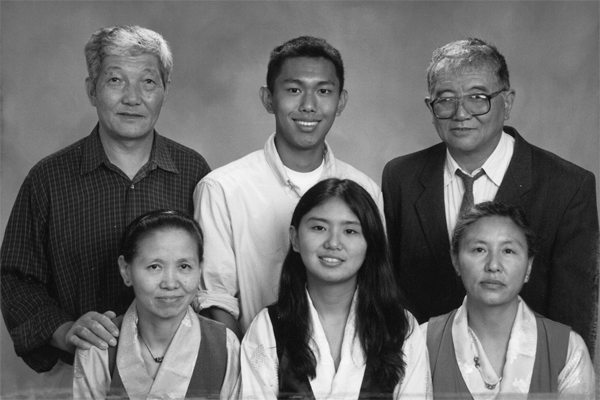I HAD NO particular difficulties along the way, and arrived in the Nepalese capital, Kathmandu, on March 13, 1983. I sought lodging with some relatives of my father’s family and spent a few days applying for permission to visit my brother in the United States and touring the holy places. I was planning to visit Dharamsala to seek audience with His Holiness and hoping to find a traveling companion, when I heard that His Holiness was soon to travel to Mön Tawang to perform a public Kalachakra initiation. Hoping to meet Him before His departure, I decided to fly, but new arrivals from Tibet had to have a letter of introduction from the representative office in Kathmandu before proceeding to Dharamsala, which delayed me for several more days. I took the flight on the 19th and arrived in Delhi only to find that His Holiness had departed that same morning. This was quite a disappointment, particularly as He was due to remain in the Tawang area for the next six weeks, and I had no relatives and even very few acquaintances in either Delhi or Dharamsala. Fortunately, however, the senior tutor Kyapjé Ling Tri-chen Dorjé-chang was staying a few days in Delhi for medical treatment, so I got to meet with him.
While waiting for His Holiness to return to Dharamsala from Tawang, I went on a tour of the holy places in India, like Bodh Gaya, Sarnath, Kusinagar, and so on, and then spent the remaining time in Dharamsala. That is the seat of the exile government and the center of the exile settlements, so besides exploring the area, I got to know more about the exile community in general and the monasteries and schools they had established in particular, and to admire the efforts made by the senior members of the community under His Holiness’s guidance. I was granted audience the very next day after His Holiness returned in early May, and fulfilled the wish that had kept me alive throughout the months and years of suffering.

Family photo 2004: from left to right, Tubten Khétsun, his nephew Tendzin Gyeltsen Khédrup, and elder brother Yeshe Khédrup. In the front row, his wife, Palden Drölma Khétsun, niece Tendzin Losang Khédrup, and sister-in-law Tsewang Palmo Khédrup. Author’s collection
From there I returned to Nepal, received my permission to travel to the United States, and arrived here on May 31. Meeting up with my brother after more than twenty years was just like the expression “reuniting with one long feared dead.” Since then I have stayed here, and although spending the better part of my life without freedom has prevented me from achieving competence in other languages, and therefore from making any great contribution in either public service or private enterprise, I have remained a steadfast and sincere supporter of the correct policy of His Holiness, unswayed by the schisms undermining the unity of the Tibetan people.
Having thus gained the opportunity to write about how I spent more than twenty years of my life as a human being subjected to animal servitude by another people in my own country, I have made great efforts to do so during my spare time, which have resulted in this book. However, I am neither a person of importance, capable of shedding new light on historical events, nor a heroic patriot with tales to tell of joining battle with the enemy; nor is my story one of miraculous survival in the face of unbearable physical ordeals. This is simply the story of what an ordinary Tibetan suffered under the Chinese occupation, and although lovers of adventure will hardly find it thrilling, it is a testament of our experience that I hope will encourage others with more extraordinary tales to put them into writing, so that the sufferings my generation went through will not be limited to hearsay but hopefully become, as much as possible, documentary sources at the disposal of the historians of the future.
Writing years after the fact, with deteriorated mental, verbal, and physical capacities, it is hard to avoid errors concerning exact dates and correct sequence, and with a request for the reader’s forgiveness of any such flaws, I conclude.
Signed: Gyatso Tashi Tubten Khétsun
21st day of the eighth month of the fire mouse or Tibetan royal year 2123 October 2, 1996